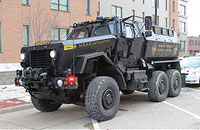Photo by Raymond Wambsgans through Flickr Creative Commons.
Allison Kao is a high school student serving as a summer intern at the ACLU of Ohio.
After two years of anticipation, preparation, and scrutiny in the national spotlight, Cleveland can finally reflect on the 2016 Republican National Convention. While the city has been praised for its peaceful management of public demonstration—particularly in light of recent of political controversies and high-profile police shootings—the continued militarization of law enforcement cannot be ignored.
Looking Back
In preparation for the 2012 RNC, the city of Tampa used millions in federal funds to purchase military-style gear, including an armored vehicle, long-range acoustic devices (LRADs), and non-lethal chemical munitions. Numerous reporters and protesters likening law enforcement presence to a “police state,” saying it
effectively chilled free speech at the convention.
Police militarization was brought forcefully into the public eye following the shooting of Michael Brown in August 2014, when demonstrators took to the streets of Ferguson, Missouri to protest police violence. In response to the protests, police arrived in armored vehicles, outfitted in riot gear with military style weapons and tear gas. This caused people across the country to question police response to demonstrators.
This issue came up locally the following May in Cleveland, during a protest after the acquittal of Cleveland police officer Michael Brelo in the killing of Timothy Russell and Malissa Williams. 70 protesters were funneled into an alley and arrested, many held for extended periods of time to prevent their continued demonstration. The
ACLU lawsuit that followed led to a new mass arrest and dispersal protocol for Cleveland police.
Read "War Comes Home: The Excessive Militarization of American Policing" and our blog, "Community Safety: A Call for a Moratorium on 1033."
Days later, the U.S. Justice Department announced it was
entering into a consent decree with the city of Cleveland , following an investigation that found Cleveland police “engages in a pattern or practice of using unreasonable force.” This agreement mandates reforms in the CPD’s hiring practices, training procedures, and use-of-force policy, though RNC preparations have led to
delays in its implementation. .
The Balancing Act
Political conventions provide effective platforms for voices to be heard on a national level, but expectations of protest draw safety concerns that law enforcement agencies must address. Too often, police turn to militaristic tactics instead of nonviolent intervention. This shift in crowd control tactics has led to local police departments looking like small armies, at the expense of people’s civil liberties and safety.
Research has indicated that approaching protesters in militarized settings triggers “deindividuation,” where officers see a group of independently-minded demonstrators as an anonymous, singular entity. As the individuals become seen collectively as “the adversary” a dangerous cycle begins, with aggressive police behavior inflaming defensive crowds. The very presence of weapons and the image of officers in riot gear threaten the people they are meant to protect.
Police militarization also communicates a dangerous message about our constitutional rights; intensifying policing in response to public speech tells us that speaking out is a threat to public safety. While public safety should always be a priority, evidence tells us that speech and safety are more not mutually exclusive and, in fact, go hand in hand.
The Test of the RNC
The 2016 RNC transformed downtown Cleveland into a key stage for political expression and national hub for law enforcement, and the results were mixed.
Various reports cited the reliance on bicycles for crowd control and the small size of demonstrations for the lack of violence or protest-related arrests. These successes, however, can also be attributed to the
police state atmosphere , where 3,300 police officers, including 2,800 from across the country, were present in Cleveland during the convention. This dramatic law-enforcement presence alone can stifle free speech. Still, the CPD clearly learned lessons from the Brelo demonstrations and utilized targeted arrests and indirect intervention rather than mass arrests and violence.
As we consider the history of police militarization—the blurred lines between security and oppression, police and soldier, safety and speech—let us continue to promote constitutional policing and foster a strong police-community partnership.

